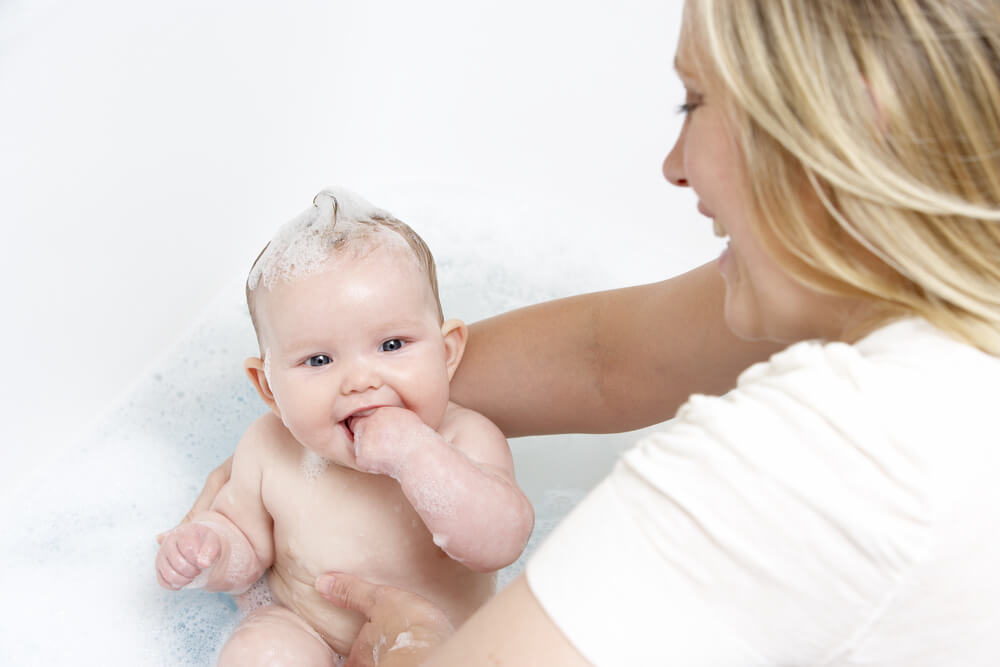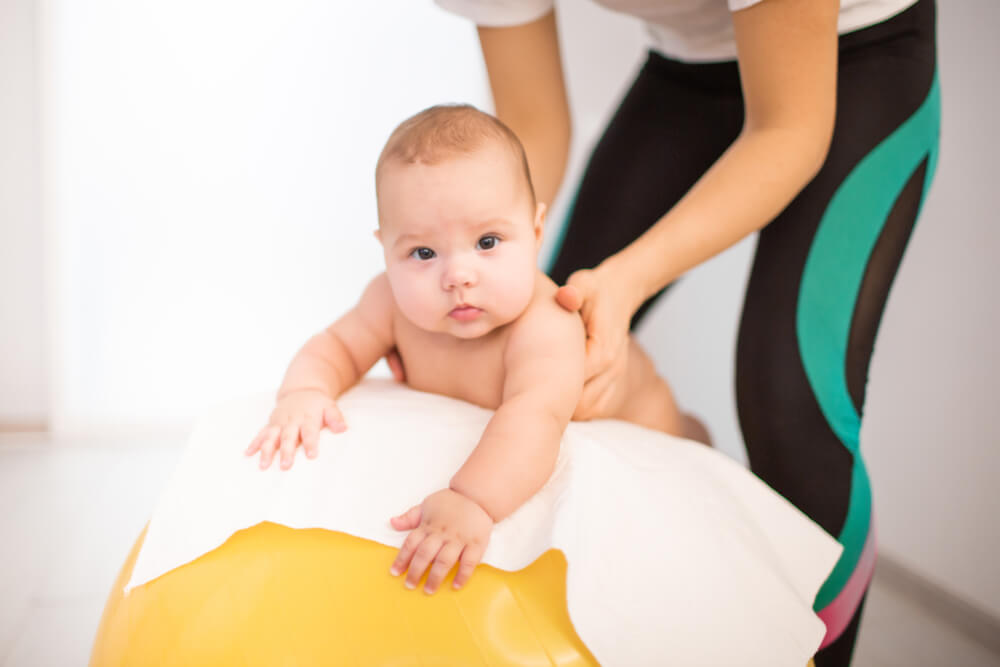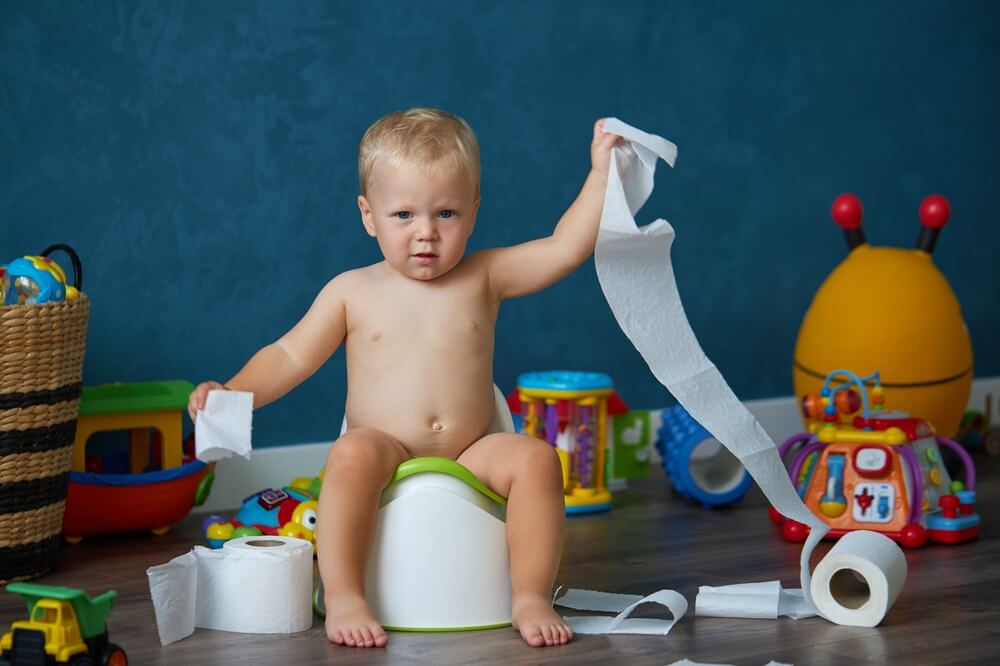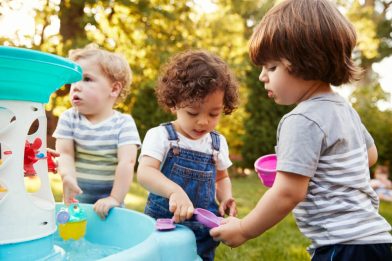What should a 5-month-old baby do?

The development level of a 5-month-old baby should consist of maintaining their physical skills, strengthening their muscle corset, and encouraging the process of crawling. During this period, the behavior, feeding, and daily routine of the baby change drastically as their teeth start growing.
Contents:
- Physical development
- What should a 5-month-old child know how to do?
- When should the parent be worried?
- How to assist in the child’s development?
Physical development

Prostock-studio/Shutterstock.com
At the stage of infancy, girls lag behind boys in all physical parameters. Boys weigh on average 0.5 kg more and are 2-3 cm taller than girls at this age. The difference between babies of the same sex is present in the first year of life, disappearing after this milestone.
Below are the norms of physical parameters for children of 5-months-old:
| Parameter | Value |
| Height | 64-66 cm |
| Weight | 6,9-7,5 kg |
| Head circumference | 41,5-42,5 cm |
| Chest circumference | 43-44 cm |
⠀
Physical abilities
Bones become stronger and more proportional. Thanks to this, tactile sensations start being more well-developed. Moreover, during this period, the digestive system starts getting more adapted to food and intestinal colics practically disappear. Children who begin to receive complementary foods in addition to formula and breast milk defecate no more than 1-2 times a day. The consistency of the stool is different and depends on the type of feeding.
Saliva is abundant due to the appearance of the first milk teeth, which can last up to a year or even longer. Gums swell and children may develop fever; the secretion of mucus in the nose may also increase.
Read more about milk teeth and when and how they fall out.
What should a 5-month-old child know how to do?

Prostock-studio/Shutterstock.com
By the age of 5 months old, the child should be able to do the following:
| Previously acquired physical skills that can manifest themselves at the age of 5 months | New skills |
| Lifting the head up when laying on the stomach | Recognizing the mother and close people |
| Holding the mother’s breast or the bottle while being fed | Consciously following moving elements around with the eyes |
| Smiling and laughing when playing | Turning on their side or adopting a supine position |
| Mumbling | Grabbing and holding the toy in firmly in the hands |
| Trying to lift themselves up from a lying position whilst being supported with the palms of their hands | Taking objects from the adult’s hand |
| Mumbling in a singing manner by pronouncing new sounds | |
| Reacting to songs and tales | |
| Staring at colorful images for a long time |
⠀
Physical abilities and reflexes

Prostock-studio/Shutterstock.com
The child no longer lies down calmly, but rather moves actively, discovering their body and testing its capabilities. They not only balance while lying on their stomach but also raise their bent legs and arms up. Movements of an extension-pushing nature start developing, preparing the baby’s body for crawling. The baby is already holding their head whilst being supported by their hands or when lying on their stomach. The baby’s head no longer tilts back when in their mother’s arms. By the 5-month-old milestone, the newborn’s reflexes fade away.
The child’s intellectual development
The age from 4 to 6 months is called pre-speech time. Children start pronouncing sounds that are not recognizable and are extremely vaguely articulated. They also start to distinguish the thumb from other fingers and begin actively using it when playing.
The perception of the world
The eye muscles are fully formed, thanks to which the baby is able to study their surroundings which they enjoy, and to follow moving objects with their gaze. They react to their parents and other people emotionally, greeting the former with a smile, and the latter with tears or genuine fear on their faces.
The baby begins to distinguish between sounds and voices, mainly their mother’s. They begin to react to sounds, the source of which may be at a distance of 5-6 meters.
The daily routine, the feeding and sleeping pattern

Prostock-studio/Shutterstock.com
The life of a child at 5 months of age consists of 6 meals a day, 2-3 daytime naps, and 1 or 2 walks in the fresh air. Each family has got a different daily routine, but the following example may be taken into account as a guide:
| Time | Activity |
| 6.00 am | Waking up |
| 6.00-7.30 am | Feeding and hygiene procedures |
| 7.30-9 am | Post breakfast nap |
| 9-10 am | Feeding |
| 10 am-12.30 pm | Walking or sleeping |
| 12.30 pm-2 pm | Feeding, games and exercising |
| 2-4.30 pm | Walking or nap time |
| 4.30-5.30 pm | Feeding, walking around the house or listening to music |
| 5.30-7.30 pm | Bedtime |
| 7.30-8 pm | Feeding |
| 8-8.30 pm | Reading books outlook or calm games |
| 8.30-9 pm | Bath and bedtime preparation |
| 9 pm | Sleep that can be interrupted by one meal |
⠀
In addition to powdered milk and breastfeeding, the baby may start receiving other foods. A pediatrician should be consulted on the introduction of early complementary foods for a 5-month-old baby during a routine examination. The doctor recommends starting adding complementary foods if the child’s weight does not correspond to the norm, or if the child suffers from constipation and burps out liquid food too often. It is allowed to give the child vegetable and fruit purees, juices, and cereals. This will be enough up to the age of six months.
The age of 5 months is a favorable time for the introduction of the following fruit and vegetables into the child’s diet:
- zucchini;
- cauliflower;
- broccoli;
- potatoes;
- green apples.
Do not aim at feeding vegetables and fruits of bright colors to your child at first, as allergies are often caused by bright foods like carrots or pumpkins.
Increase the portion little by little, starting with ¼ of a teaspoon per day, then switching to ½ teaspoon and later on, raising this quantity to 100 grams by getting towards the 5 months mark.
A green apple is best to be served baked rather than simply mashed. Use homemade puree or store-bought puree. If you cook yourself, make the most of your seasonal vegetables. If you buy baby food at the supermarket, pay attention to its expiration date.
Taking care of a 5-month-old child

Prostock-studio/Shutterstock.com
The baby is required to be bathed and taken care of throughout the day.
Here is the list of daily hygiene routines:
- Cleaning the nose.
- Wiping the skin in the ear auricle and behind the ears with a damp flannel.
- Washing up the child with warm water.
- Applying powder on the rashes.
- Cleaning the child’s face and hands by wiping them with a soft and damp cloth.
- Changing diapers after every bowel movement.
- In the evening, bathe the baby for half an hour. Extracts of medicinal herbs such as chamomile or thyme can be added to bathwater. The baby can be entertained with toys during bathtime.
Trim your 5-month old child’s nails at least 2 times a week, and clean the surface of their favorite toys. Disinfect wooden, rubber, and plastic toys with boiling water.
What should the baby be kept away from?
The heightened interest in the world around the child increases the risk of injuries due to falls and shocks against furniture. Do not leave the child alone during games.
The introduction of food into the diet may cause digestive issues in the child. Therefore, they can become an addition to the fever and bad sleep that are caused by the growth of teeth.
No one is immune from problems, however, what you can do as a parent is to make sure that you are ready for them. Make your house safer by removing all fragile items from tables and shelves. Set some limits for the area of movement of the child by surrounding it with pillows around the sides. If you are playing on the sofa or bed with your child, do not leave them alone. In this case, pillows will not be enough as the child can fall on the floor and get injured. Set a special carpet or bed for playing at home. To soothe the child whose teeth are growing, buy a teething toy and some special gum gel that will relieve the pain that will have an antibacterial effect, and will contribute to the healing of the gums.
Read more 10 Tips To Help Single Parents Make Their Homes More Child Friendly.
When should the parent be worried?

Prostock-studio/Shutterstock.com
If the child is lagging behind in their development, parents can notice coordination disorders, lack of interest in the world around them, and reactions to changes in colors or sounds. Watch your baby carefully before becoming very worried and running to the pediatrician. Spend more time with them to notice even the slightest changes in their behavior.
You need to be worried when you notice the following in your child:
- they do not pronounce the simplest syllables and consonants, their speech rather consists of long-sounding vowels. They do not aim to pronounce new sounds, but continue to mumble, as at the age of 4 months;
- they do not try to pull up or rollover on the stomach from the back, even when an adult helps them;
- the child does not turn around and does not change their facial expression when a quiet conversation of adults replaced by an emotional one;
- the baby does not remove the fabric that covers the eyes when lying on the back. They would normally try to remove the obstacle that hinders their eyesight;
- they do not resist when their toy is being taken from them. Children at this age hold on to objects strongly and do not give them away without demonstrating discontent;
- they cannot clamp the ball with their hands that is handed over by adults;
- they do not display interest in new objects that appear in sight. If a moving object appears in front of the child, it should quickly switch their gaze when seeing it;
- the child does not follow the mother with their eyes, when she is moving around the room, and stares in one place;
- they cannot hold their head and do not contract their body when they are lifted up by their parents;
- they cannot relax their muscles on their own. The excessive muscle tonus issue can be resolved by gymnastics and therapeutic massage.
Consult a pediatrician when noticing any deviations from the norm.
How to assist in the child’s development?

Prostock-studio/Shutterstock.com
Leave the desire to grow a genius out of your child and focus on the physical, sensory, emotional, and speech development of the baby. Diversify your daily routine with classes aimed at obtaining new skills through playing simple games that would facilitate development. All exercises surely do not need to take place in one day, however, light sports activities need to take place on a daily basis.
Physical development
An hour after feeding, put a child on the fit ball or a different big ball on the back or the stomach whilst holding their hands. Slowly move the ball from side to side or in circular motions. If you do not have a ball, stroke the child in circular motions, rubbing or kneading their muscles, as a form of passive gymnastics.
Here is a good exercise to strengthen the muscular corset of the child and keep the mother’s abs firm at the same time. Lie on your back and put the baby on the belly, and hold them with legs and knees bent. Lift your shoulder blades off the floor and keep the lower legs parallel to it. Swing the child from side to side, whilst holding them in their arms. An exercise that involves some slight twisting to work out the abs can also be performed from the same position.
Stimulate crawling, by performing an imitation of it together with the child. Put the baby on their stomach, and put your left hand under their body. Your right hand will maintain their knees bent. Lift the child up with your left hand slowly, and push them slightly forward with the right hand. This way, you will be able to get the child to crawl up to a meter, if this exercise is repeated regularly.
The 5-month-old baby can be swinging from side to side on their stomach, with their movements resembling swimming. The child can be put on a flat surface and surrounded by various toys from different sides. They will try to reach them, pulling the hands forward and trying to crawl towards where the object is.
Talking and fine motor skills

Prostock-studio/Shutterstock.com
Massage your child’s fingers and hands, and walk with them around the house, whilst showing them different items and pronouncing their names, colors and shapes. Fill a fabric bag with buckwheat to stimulate the child’s nerve endings on the fingers.
Place different images or put books around the house with 1 or 2 characters depicted on them. Walk around with the child in your arms, whilst stopping in front of these images. After calling out what is depicted on the image, step back to the side slightly and pronounce the name of the character again. The child can start looking around, trying to find the image they have previously seen.
Thought process
Purchase your child a music toy with buttons, music, and lights. Press the baby’s finger on different buttons, pausing for a few seconds so that they can hear the difference between different sounds.
Play a game that allows predicting the outcome of the action, with your child. Pronounce one sound a few times when covering your face with your hands in front of the child, and then removing your hands aside. At first, the child will laugh, but then they will stop reacting emotionally as they would already predict the outcome.
Perception

Prostock-studio/Shutterstock.com
Your baby discovers the world by looking, touching, biting, and licking various objects. Support them in this endeavor by making a special touch box from different objects. Take a basin or a cardboard box with high side parts. Fill it with objects of different textures, such as pasta, raisins, nuts, buttons, bits of different fabrics, and others. They should differ in shape, size, and texture. The child should also be able to throw the contents out of the box, so be prepared for a mess.
Create the first works of art together with the baby. Put a cloth or a newspaper on the floor in order not to stain it. Prepare a jar with paint and white paper. Sit on the floor and put your child in front of you. Dip their finger into the paint and put it against the paper. This will allow you to make the first toddler prints that you would be able to keep as a memory. Use fruit or vegetable puree if the child tends to put their fingers into their mouth. You will not be able to paint with it, but you will surely leave some splats on the paper.
A five-month-old baby becomes more active and willing to explore the world. They acquire new skills and their diet starts expanding gradually towards the 6-month milestone. The child’s development process should be focused on strengthening muscles and improving tactile sensations at this stage.
Проверьте электронный ящик



















